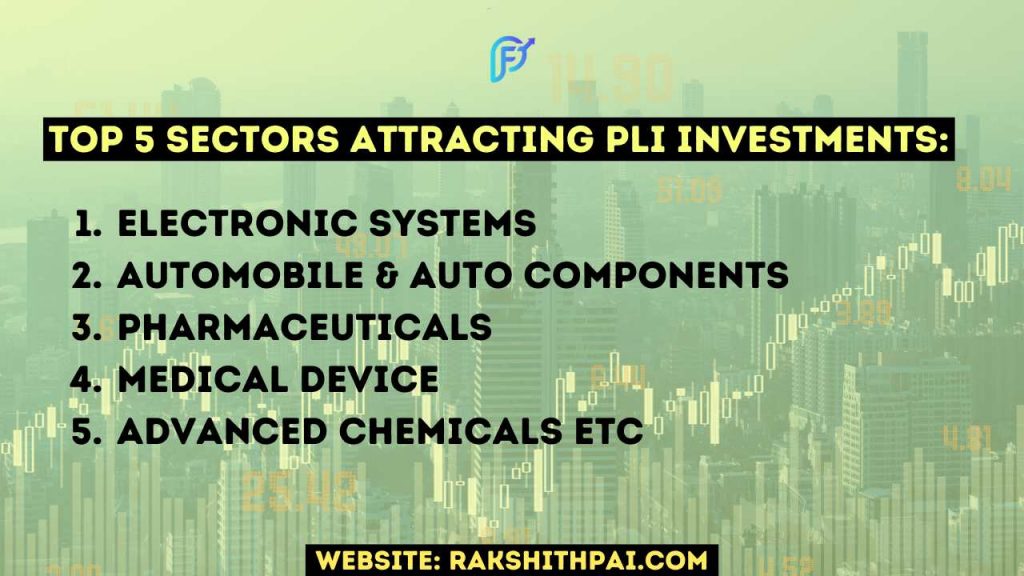Table of Contents
What is the PLI Scheme?
The PLI Scheme, which stands for “Production Linked Incentive Scheme,” is an initiative of the government of India. Its goal is to not only encourage Indian and foreign companies to set up shops in India and create jobs but also to get sectors and sub-sectors to work together and make India the next manufacturing hub.
Since the pandemic, China plus 1 factor has been revolving around us. The world needed what China could offer, but with sustainability and growth. And our first option is India.
So, programs like “Make in India,” “StartUp India,” and “Atmanirbhar Bharat,” to name a few, were initiated by the central government.
Under the PLI Scheme, the manufacturing sector is given utmost importance. The Indian government will spend Rs 3.5 lakh crore on 14 PLI schemes. The government estimates that the minimum production in India as a result of PLI will reach Rs 37.5 lakh crore ($500 billion) in the next five years.
Understanding Production Linked Incentive Scheme (PLI):
In order to encourage more domestic manufacturing, the government has introduced the PLI scheme. The PLI is concentrated mainly on the niche market, the demand for which is available locally. So, with PLI, the government wants to cut down on the number of goods we buy from other countries. This will save more of our valuable dollar reserves and make the trade deficit better.
By offering incentives on top of existing sales, the PLI scheme entices domestic businesses to develop or expand manufacturing units in order to boost output. The Director of ICRIER emphasized the need to balance the country’s imports and exports without favoring either one over the other. As long as homegrown manufacturing is given the attention it deserves, this is feasible.
The sheer size of the country’s population means that the government can focus its attention where it will do the most good—on attracting foreign investment. However, the capital-intensive expansion can only provide profits over a very long time horizon, which is something that can be comfortably covered by outside investment. It may be possible to achieve a trade balance if the government instead prioritizes industries with a short time horizon (less than a year) for seeing results.
7 Best Sectors for Wealth Creation by 2030:
What is offered under the PLI Scheme?
Under the PLI Scheme, the Indian manufacturing sector will get the following:
Integration
Begin with one sector/sub-sector and then integrate forward and backward as needed.
Integration of economy is also noticed with an estimated 1 crore job creation in the next 5 years. And a signification enhancement in production valued at over 500 Billion US Dollars.
100% Automatic FDI
Foreign Direct Investment will be streamlined. Due to the PLI scheme, India saw the highest ever FDI inflow of about 81.97 Billion US dollars in the Fiscal year 2020-21
Such investments were made in many investment projects, including a total of 863 investment projects under active consideration with investments amounting to 121 Billion US Dollars as of 2021.
Tax Break
The PLI scheme will offer tax breaks and other financial benefits to help the sectors that need them. Companies registered under the PLI program get tax breaks based on their performance and the industry they registered for.
Duty Cut
Reduced duties will make companies’ products much more competitive in the domestic and international markets.
For instance, Large Scale Electronics Manufacturing Eligible businesses will receive, for a total of five (5) years after the base year as indicated, an incentive of between four percent (4% ) and six percent (6%) of incremental sales (over the base year) of products made in India and covered under target segments.
Single Window Clearance
Make it easier to start and run a business by streamlining the different processes and approvals that are needed. The initiative stresses the elimination of “red-tapism”. Such actions have resulted in an amazing performance by India.Inc.
Today, India’s Ease of Doing Business ranking is at 63rd position, a big jump from 142nd position in 2014.
Why should you invest in PLI-availing companies?
Under the PLI scheme, participating companies will get either subsidies, monetary benefits, tax concessions, and the like. PLI is a group of government programs that help India’s manufacturing industries in different ways.
So, it is suggested to look at those entities that get the most out of the scheme so that they, their shareholders, and everyone else involved can all benefit.
Under the PLI scheme, the entities signing up are given benefits as they produce more and breach their production targets. Such an event will be a win-win for both the company and the economy as a whole by creating more employment, better infrastructure, competitive spirit, and, most importantly, incentives for efficient management.

Top 5 Sectors & Sub-sectors Attracting PLI Investments:
Electronic Systems
Large-Scale Electronics Manufacturing and IT Hardware for Enhancing India’s Manufacturing Capabilities and Enhancing Exports. As a result, reliance on China is reduced. The scheme will cost between Rs.40,000 and Rs.47,000 crore.
Examples: Havells, Panasonic, Dixon, etc.
Automobile & Auto Components
Investments into the auto industry’s entire value chain, mainly concentrating on the upcoming needed technologies such as electric vehicles and accessories. The scheme outlay is worth close to Rs.
Examples: Sona Comstar, Bharat Forge, Lumax, etc.
Pharmaceuticals
To boost domestic manufacturing capacity, including high-value products across the global supply chain. The Scheme Outlay is worth close to Rs. 22,000 crores.
Examples: Reddy Laboratories, Lupin, Mylan Labs, etc.
Medical Device
promoting domestic manufacturing of medical devices and providing a much-needed boost to India’s vision of becoming a global manufacturing hub for medical devices The scheme outlay is worth around Rs. 18,500 crores.
Examples: Philips Global Business Services LLP.
Advanced Chemicals
Industry Chemicals and Advanced Chemistry Cell Batteries for Enhancing India’s Manufacturing Capabilities and Enhancing Exports. The scheme’s budget exceeds Rs. 18,000 crores.
Examples: Ola Electric, Mahindra & Mahindra, L&T, etc.
5 Futuristic Sectors to Invest in India:
Conclusion:
Governments often use the Production-linked Incentive, a tried-and-true tactic for increasing the output of items seen as important for creating jobs, advancing social welfare, and generating tax revenue. PLIs, or profit-linked incentives, are monetary bonuses given to companies in exchange for increasing production. Tax breaks, reduced import/export fees, and relaxed land acquisition policies are all possible examples.
In most cases, the savings made possible by a PLI program will be passed on to the final buyers of such products. For attracting substantial investments in mobile phone production and unique electronic components like the ATMP units, for instance, the PLI plan for electronics manufacturing in India provides incentives to boost local manufacturing.
The electronics manufacturing industry in the nation will see dramatic growth as a result of the strategy. This will help the country keep its place as the leader in the world when it comes to making electronics.
For More Information, Check this Video:
Disclaimer: All the information on this website is published in good faith and for general information purposes only.









